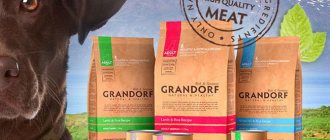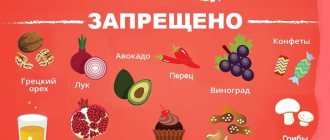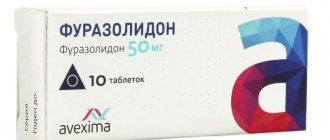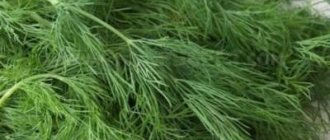The benefits of different types of meat
There is a wide variety of products on the market. Meat products are no exception. For pets you need to choose only the best. After all, meat for dogs is an energy resource and the key to their excellent health.
Predator instinct in action
Beef
It is the main source of iron, which affects the level of hemoglobin in the blood. Gives a boost of energy. In addition, it is a hypoallergenic product. It is beef that is given to very young puppies to try when they are weaned from their mother. Moreover, it is better to offer not fillet pieces, but ones with veins and vessels, cartilage and film, since such parts contain gelatin and collagen, which have a positive effect on the bones and blood vessels of the pet.
Important! Veterinarians point out that you should not feed your dog only beef, since not all the microelements that the dog needs are contained in this meat.
Mutton
Also a good option for a pet. Is an alternative to beef. Contains B vitamins needed to improve muscle tissue and cardiovascular activity. In addition, lamb is considered a less fatty product.
Rabbit meat
Rabbit meat is a dietary, lean meat, and also hypoallergenic. Contains many proteins necessary in the animal’s diet, vitamins B and C, and minerals. Beneficial for dog digestion.
Attention! Rabbit carcass is contraindicated for animals with problems with the kidneys and biliary tract. Rabbit meat promotes the formation of uric acid in the body, which diseased organs are not able to remove. It accumulates and settles on the walls of blood vessels, which can lead to arthritis.
Venison
Source of a large number of B vitamins and minerals. Very useful for the animal’s cardiovascular system, as well as the digestive tract. However, meat is difficult to find for sale. And if available, the price of such a delicacy will be fabulous.
horsemeat
In terms of absorption by the body, it is better than beef. This is dietary meat, containing almost no carbohydrates. Not suitable for all dogs: active and active dogs simply will not receive enough energy for their activities. Horse meat is more suitable for domestic “sloths” or animals recovering from illness.
Chicken
Contains a lot of protein, as well as potassium and phosphorus. Although it is considered dietary meat, it is classified as a highly allergenic product. The reaction usually occurs to store-bought chicken, which contains many antibiotics used in poultry farming. If it is possible to buy proven homemade chicken, then it can be included in the dog’s diet in small quantities.
Turkey
An alternative to chicken is turkey. Also a very low calorie product with a high protein content. In addition, the meat is enriched with vitamins A and E, potassium, magnesium, and iron. Easily absorbed by the body.
Duck
A source of protein, amino acids, contains zinc, iron, phosphorus, vitamins A, B, E, etc. Promotes the functioning of the cardiovascular system and improves metabolic processes in the body.
It is good to use meat by-products in the menu, but their amount should not exceed 20% of the total diet of a pet.
By-products for dogs are a special treat
The benefits and harms of meat for dogs
Meat should make up the majority of a dog's diet. From it the animal receives the maximum of substances necessary for life, which contribute to:
- replenishing the body with energy;
- strengthening the skeleton;
- building muscle mass;
- stable functioning of the hematopoietic system;
- improving the quality of coat and skin condition;
- general strengthening of the immune system.
Expert opinion
Kuzmenko Olga Olegovna
Information about the expert
Ask a Question
You should choose pulp of low-fat varieties. The fatty product is difficult to digest and stimulates the occurrence of diseases of the digestive system.
The benefits of different types of meat
- Pork. Not recommended for feeding puppies and pet dogs prone to obesity. Its lean parts are suitable for large breeds kept in open-type enclosures. The best time for such complementary feeding is winter, when serious energy replenishment is required.
- Beef. The best solution for the animal in terms of benefit and cost. Rich in organic iron, it does not cause allergic reactions. And its fat maintains energy balance in the body. It is best to start feeding puppies with this meat. Moreover, mature beef contains significantly more useful substances than young veal.
- Chicken. A controversial product because it often causes allergies. At the same time, it is a source of easily digestible protein.
- Rabbit meat. An excellent source of highly digestible protein. Allergies from its use occur extremely rarely. Used when necessary for dietary nutrition.
- Horse meat and lamb. Low-fat product that does not cause allergies. Rich in B vitamins. Better absorbed than beef.
- Offal. They cannot replace meat in terms of nutritional value, but they also have valuable properties. For example, beef tripe contains iron, phosphorus, and zinc. In its raw form, it retains particles of digestive enzymes. They help the dog's intestines cope with plant fiber. And the liver contains iron and folic acid, which is important for the body. Its deficiency results in pregnancy pathologies, inflammation of the mucous membranes and anemia.
Possible harm from meat products
Despite the benefits of meat, it also has negative effects:
- Any raw product can become a source of infection. You cannot feed the carcasses of dead animals, because the cause of death is not hunger or old age, but infectious diseases.
- Kidneys and liver require special preparation before use. They accumulate many toxins, naturally cleansing the animal’s body. They must be soaked and then scalded with boiling water.
- Chicken often contains growth hormones and all sorts of dietary supplements. Therefore, it can cause allergies in dogs. It can also become a source of salmonella infection.
- The flesh of wild animals can contain worm eggs and viruses of severe infections. It can only be fed boiled.
In what form should you serve the meat – boiled or raw?
The share of meat in a dog’s diet should be at least 50%. Moreover, the dog’s diet can be diluted with different types of meat products to fully saturate the body with vitamins, minerals and amino acids. But a dilemma arises: should you give your dog raw or cooked meat?
Is it possible to feed a cat raw meat and only raw meat?
The opinions of dog breeders on this issue are polar. And everyone defends their position. On the one hand, dogs are essentially carnivores and eating raw meat is in their blood. Their digestive system is able to digest it in this form and at the same time take the most useful substances for the body from food. And during cooking, protein and vitamins are destroyed. Therefore, boiled meat is considered a purely carbohydrate product and the feeling of hunger comes faster.
On the other hand, supporters of thermally processed products are of the opinion that raw meat contains harmful and even dangerous microorganisms for animals: parasites, viruses, bacteria. And the loss of useful microelements during cooking is not significant and can be replenished with other products: vegetables, herbs, cereals.
Important! Professional dog handlers say that it is unlikely that dogs become infected with parasites from food, since the gastric juice of a quadruped is highly acidic, and harmful microorganisms are simply not able to survive in it.
Thus, whether it is possible to give a dog raw meat or cook it is up to the owner to decide. However, there are meat products that need to be thermally processed so as not to harm your four-legged friend. These include:
- Meat from animals obtained by hunting (it is not known what the animal was sick with, so it is not worth risking your pet’s health).
- Chicken meat (often when breeding chickens on an industrial scale, they are injected with a huge amount of antibiotics that can cause allergies).
- Some by-products: kidneys and liver (in the body they play a cleaning function and harmful substances accumulate in them).
Raw or Processed: Benefits and Possible Dangers
In what form is it healthier and safer to serve meat? Is it possible not to cook and give fresh raw meat to the dog to eat? Not only is it possible, but it is also necessary. All valuable proteins, minerals and vitamins are contained in raw meat.
The nutritional value of raw meat is incomparably higher; it is absorbed by 50-60%. This is explained by the fact that the dog’s stomach is best suited for digesting proteins.
Meat of domestic farm animals and birds (cows, horses, rams, rabbits, chickens, turkeys), purchased in a store or market, can be considered safe and uncontaminated. It is necessarily subject to veterinary and sanitary supervision. If its quality and freshness are not of concern, the dog should be given raw meat.
Is it possible for a dog that goes hunting with its owner to be allowed to eat wild mice, hedgehogs, frogs, and foxes? Absolutely not. The meat of wild animals can be contaminated with parasites and serve as a source of dangerous infections. It definitely needs to be cooked.
To avoid the risk of infection with worms as much as possible, the pieces prepared for feeding are frozen and kept in the freezer for several days. When the temperature drops sharply, the parasite eggs die.
There is one more limitation. When a dog has given birth, the bitch should not be fed meat for the first five days after giving birth. Such high-calorie foods can provoke increased lactation. Weak newborn puppies will have difficulty coping with a strong flow of milk. The result can be mastitis in the dog.
Boiled meat decreases in size during cooking, while the bulk of the proteins remains in the broth. This processing method destroys valuable vitamins and amino acids. Accordingly, nutritional value and satiety are reduced. If you give boiled meat to your pet, then the portion will have to be increased almost three times. The broth should only be used if a suitable replacement is not available.
When preparing a dish for a dog, do not use salt or other spices. Smoked meats are also prohibited for dogs. The additives that they contain have a negative effect on the liver.
Toy dog breeds are more likely to suffer from chronic diseases and are prone to allergies. Therefore, it is advisable to offer a small indoor individual a piece of boiled meat.
Why do raw food dieters recommend it?
Is it possible to feed a dog dry and natural food at the same time?
Adhering to the point of view that dogs should eat meat in its pure form, without heat treatment, supporters of a raw food diet cite the following arguments:
- Such meat contains a more complete complex of useful and nutritious elements, an optimal ratio of proteins, fats and carbohydrates necessary for the pet’s body.
- During heat treatment, protein is destroyed and vitamins are lost.
- The dog’s digestive system is designed in such a way that it absorbs the product much better in its raw form than in boiled form.
- Since meat is a fairly filling product, the animal eats up faster and in small portions.
It is not advisable to mix natural products and dry food in the same diet
How to give a raw product correctly to avoid trouble
Why dogs can’t eat pork: can you feed it or not?
If the owner decides to add raw meat to the pet’s menu, then he should adhere to a number of rules so as not to cause harm:
- Before feeding, a piece of meat should be doused with boiling water to remove pathogens.
- Another way to kill dangerous germs is to freeze meat for 1-3 days. Then it is transferred to the refrigerator for gradual defrosting.
- When eating a raw food diet, especially when eating raw meat for the first time, you need to start with a small portion and monitor whether there is an allergy to the product or whether there are gastrointestinal disorders. If everything is in order, next time you can give a larger portion.
- Remove a piece of meat from the bones.
- Try to feed lean parts to avoid liver problems in the future.
- Buy only high-quality and fresh products, and under no circumstances feed them “rotten meat.”
- Give food in large pieces so that the dog can tear it up and chew it and, thus, clean its teeth.
Important! It is not recommended to mix natural and dry food in one meal, since it may disrupt the functioning of internal organs.
Dogs' diet should be balanced
Recommendations and standards for feeding dogs meat
It is necessary to feed meat at least 2 times a day. The amount of raw product depends on the breed of dog, its weight and age. For a domestic dog, the portion is 20 g per 1 kg of weight, for a sick or active dog - 30 g per 1 kg of weight. You should not constantly feed your dog only meat; you need to include fish, vegetables, herbs, cereals, and dairy products in your pet’s diet. And do not forget to periodically give the animal anthelmintic drugs for preventive purposes.
Raw meat is a completely natural food for dogs and you shouldn’t give it up. You just need to take a serious approach to choosing it and presenting it correctly. And also do not forget that the animal’s menu should include other products that will make the dog’s diet more balanced.
Differences in the diet of dogs of large, medium, small breeds
Wild dog with a piece of meat
The daily amount of meat for dogs cannot be the same for everyone. It depends on the size of the pet, its body weight, health status, age and physical activity. For example, for an adult German Shepherd weighing 35 kg per day, it is necessary to allocate 400 g of meat per day with average physical activity.
Many dog breeders do not know whether it is possible to feed their dog raw or cooked meat. You want to pamper your pet, and besides, natural food seems healthier than dry food. You need to know certain recommendations on what to feed your pet so that it grows healthy and healthy.











